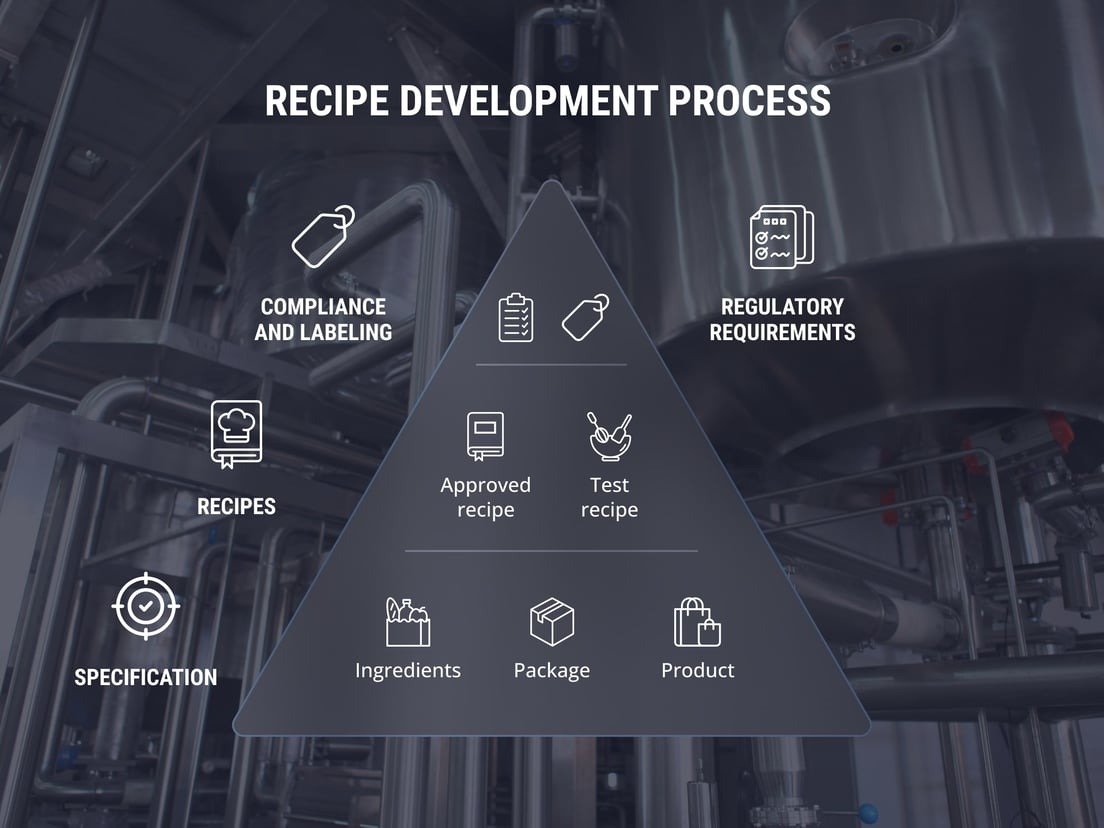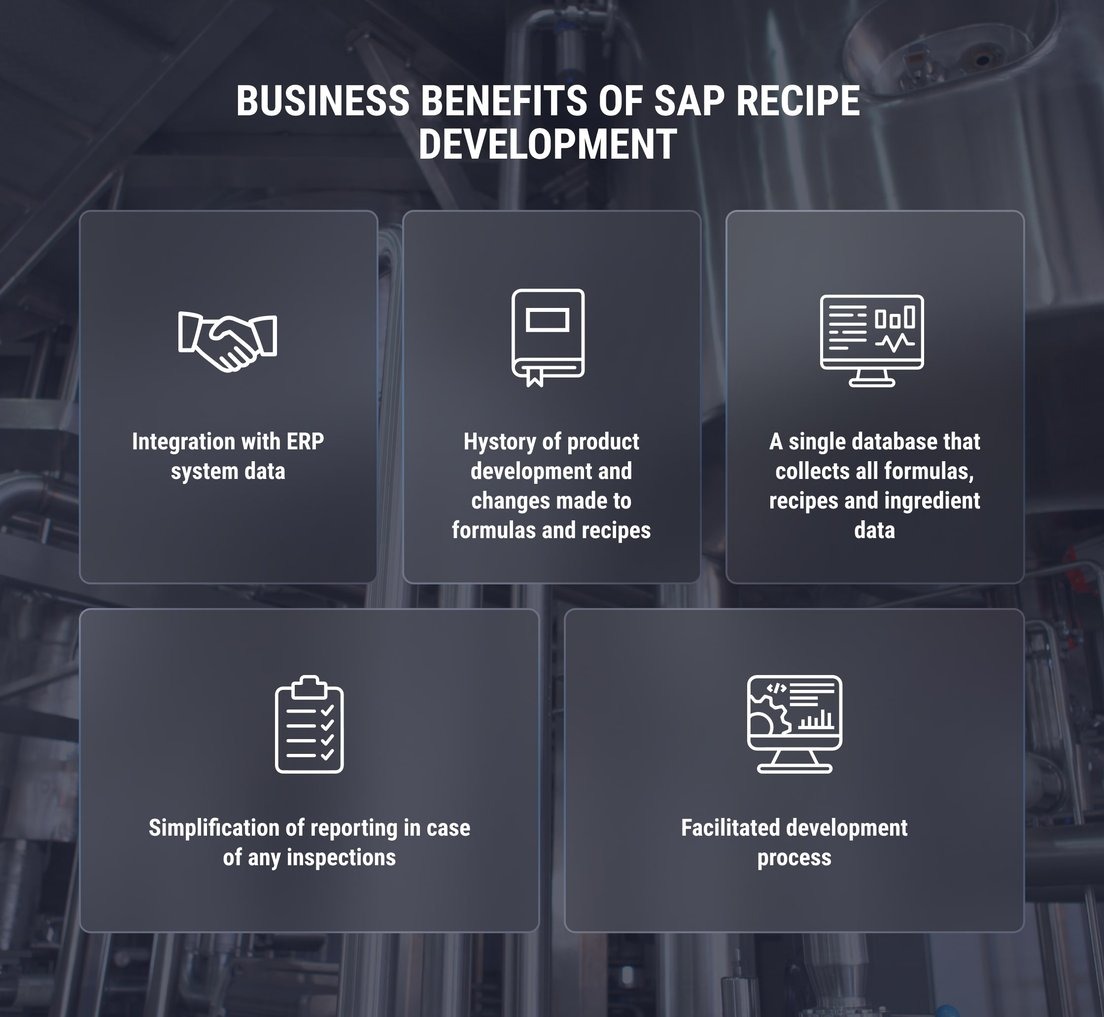SAP Recipe Development will accelerate the product development process and its manufacturing at every stage of the lifecycle.
How to Develop a Perfect Product Recipe with SAP
A study found that the amount of solid household waste worldwide will increase from 2.1 billion tons in 2023 to 3.8 billion tons by 2050. One of the main reasons for such high waste levels is inefficient production processes.
Incorrect nutrient counts and production parameters, errors in equipment settings, unoptimized recipes for future products, and lots of manual labor — all lead to low production efficiency and high costs while also complicating regulatory compliance. However, these are just a few issues that manufacturers have to address every day.

Recipe Development and Product Manufacturing Pitfalls
Spoiler: they are common to almost every production stage.
Creation of an “ideal” recipe
Formula development for a future product includes taking into account all the ingredients and nutrients, its chemical and physical properties, temperature, and even the packaging in which the product will be stored. In other words, when creating a recipe, it is necessary to take into account many factors that affect the product that will go to store shelves.
Optimization of formulas and recipes
It is practically impossible to create a recipe that can be considered “correct” in all respects: the one that would take into account all factors. So the manufacturer needs to make more than one change in the composition of the final product and its production process before the final version will be approved.
The more recipes, the harder is controlling
Manufacturers need to constantly invent new products, as well as make changes to existing recipes to improve them. That's why the number of available formulas and recipes always grows, and it is quite challenging to control all the data associated with them.
The cost of a mistake
Despite the desire of businesses to automate production processes, including the processes associated with recipe development and the production stage, a large amount of manual labor is still the stone that drags down performance indicators.
And this is not only about speed and performance but also errors associated with the human factor. In the pharmaceutical, food, and chemical industries, such errors can lead to a range of issues, from financial damage due to a spoiled batch of products to lawsuits due to the harm made to customers' health.
Different regions — different laws
If the company's products are manufactured for the local market, the business does need to comply with the regulatory requirements of different countries. The thing to do is to set everything up under the legislation of one country, whether the talk is about harmonizing products, labeling, or packaging.
However, if you run a business that sells products to different regions and has affiliates in different countries, you have to be aware of the legal and regulatory requirements of each region.
Keep Your Products Safe and Competitive with SAP PLM Recipe Development
SAP Recipe Development (SAP RD) is an add-on for SAP S/4HANA used by the food, chemical, tobacco, and pharmaceutical industries to develop new formulas, product recipes, and labels. Its main goal is to support a product's life cycle, from the stage of its development to production and labeling.
What are the target industries for SAP RD?
Food, tobacco, pharmaceutical, and chemical industries are the focus for SAP RD.
How does SAP RD help your business?
The main features of the solution include:
- Creation, visual representation, and modification of all available recipes
- Display of formulas in the table format for the convenience of entering the starting substances and their alternatives
- Ability to display and change several recipes at the same time
- Formula optimization
- History of all actions and any changes made to the recipe
- Determination of the parameters of the production process — temperature, pressure in the boiler, etc
- Determination of requirements for equipment and production processes
- Calculation of the required amount of ingredients, nutrients, as well as production costs
- Consistency check
- Uploading data for one or more recipes
- Synchronization of recipes, production specifications, and master recipes

What are the benefits of SAP RD for businesses?
The most important fact here is that SAP RD is integrated with SAP ERP data. Therefore, you can use material master records, specifications, and other data from the SAP ERP system. It means there is no need to use third-party solutions for recipe data management, which saves money on their maintenance and integration.
SAP RD stores the history of changes made during the entire product development process. All info is provided in a unified database available for employees anytime they need it. The database simplifies reporting in case of planned or unplanned inspections (e.g., initiated by FDA) and streamlines a new product development process as all recipes, formulas, and ingredients are kept in one place and located in two clicks.
Other advantages of the SAP RD solutions include:
- Intuitive user interface
- Viewing and changing several recipes or formulas at once
- Adjusting formulas and recipes
- Defining the requirements for equipment and production processes
- Calculation of production expenses, and much more
One of the first companies to implement SAP RD in their production was Nestlé, which y started its partnership with SAP in recipe development and management in 2003. Today, it has access to the latest capabilities in target-based recipe development, including:
- Recording specifications for ingredients and packaging
- Development and management of recipes for manufacturing of semi-finished products and finished products
- Access to regulatory data for compliance purposes
- Functionality that allows transferring the recipe to production, etc
SAP RD helps Nestlé to manage over 700,000 specifications and 400,000 recipes.
LeverX’s SAP RD Project Experience
Implementation of SAP RD for a milk processing leader
For a world-leading milk processor, we developed enhancements in the Recipe Formula and Composition tab screen to support custom-specific calculations, set up the additional automation of data provisioning to SAP RD Labels, and enhanced a standard SAP RD-SAP MDG (Master Data Governance) integration.
LeverX implemented and adapted SAP RD for a tobacco company
We’ve also partnered with a leading tobacco company in the USA and customized new product development and production planning processes, integrated SAP RD with SAP Quality Management, migrated recipes from SAP Recipe Management to SAP RD, and implemented a regulatory reporting system.
Configuring SAP RD for a consumer goods manufacturer
In collaboration with a global consumer goods company, the LeverX team configured the SAP RD system, implemented the SAP specifications databases, integrated the RD application with SAP Procurement and Production Planning, provided the integration with SAP QM, and developed upload utilities for data migration.
LeverX collaborated with SAP on numerous RD development and support projects
Together with SAP, our team has developed a Fiori app called Recipe Finder. It allows for finding proper recipes based on specific criteria. We also created apps for managing recipes, specifications, and labels.
Leverage LeverX Project Experience for Your Business Success
LeverX experts will not only implement SAP PLM Recipe Development into your system; they will also help you refine the system to suit your business needs. We will also develop additional utilities for the efficient operation of the solution.
If you have any questions about how SAP PLM Recipe Development works and how it can benefit your business, feel free to contact our experts. We will be happy to assist you!
How useful was this article?
Thanks for your feedback!



.jpg)